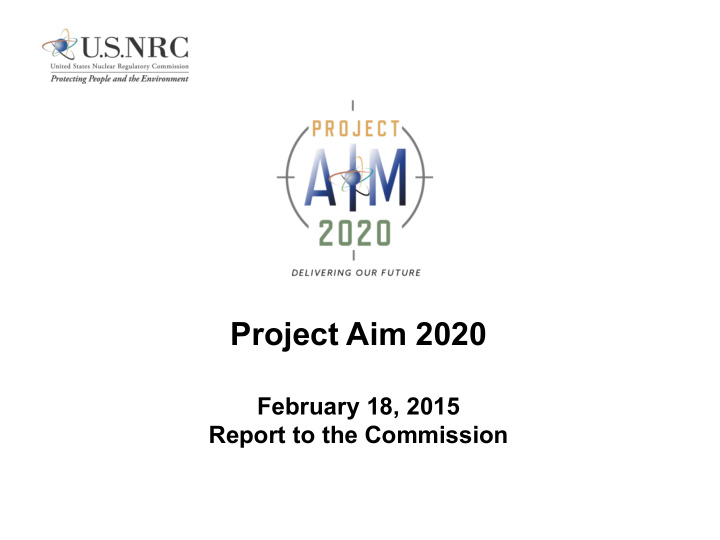



Project Aim 2020 February 18, 2015 Report to the Commission
Agenda • Purpose • Why change? • Approach • What we might look like in 2020? • Roadmap and strategies • Communication and implementation 2
Purpose Project Aim seeks to provide: • Recommendations for improving the current and projected performance • Concrete and specific projections of the workload for the agency five years out • Recommendations for agency resource levels and workforce staffing 3
Why Change? • Improve efficiency of operations – Right sizing the agency – Streamlining processes – Enhancing timeliness – Working as “One NRC” 4
Project Approach 5
Workload Forecast by 2020 • Operating Reactors – Down slightly • New Reactors – Down significantly • Fuel Facilities – Down slightly • LLW & Decom – About the same • Spent Fuel – About the same • Nuclear Materials Users – About the same • Corporate – Down slightly 6
Workforce Competencies by 2020 • Operating Reactors – About the same • New Reactors – Less construction • Fuel Facilities – About the same • Low Level Waste & Decommissioning – About the same • Spent Fuel – About the same • Nuclear Materials Users – About the same • Corporate – Shifts in financial management, IT, and human resources 7
What Might We Look Like in 2020? 10% Smaller by 2020 ~ 3400 FTE ~ $900M 8
OFFICIAL USE ONLY – SENSITIVE INTERNAL INFORMATION 9 OFFICIAL USE ONLY – SENSITIVE INTERNAL INFORMATION
People Strategies 1. Ensure the NRC has the right number of people with the right skills at the right time 2. Enhance employee agility to meet the demands of a changing environment 3. Focus on “One NRC” concept 10
Planning Strategies 1. Improve the planning and budget formulation process 2. Re-baseline the work of the agency 11
Process Strategies 1. Improve transparency and simplify how the NRC calculates and accounts for fees, and timeliness of communicating fees 2. Improve operating reactor licensing process and other key regulatory processes 3. Clarify and standardize processes, roles, and responsibilities 12
Communication & Implementation • Requirements for success – Alignment and commitment – Actionable strategies – Leadership and accountability – Performance monitoring – Frequent, effective, and diverse communications – Reinforcing desired behaviors – Stakeholder engagement 13
Recommend
More recommend